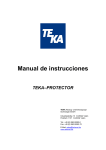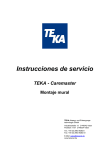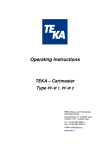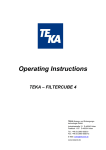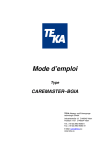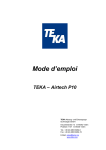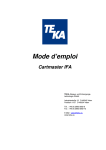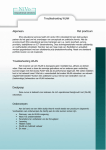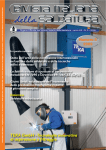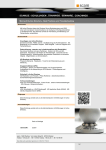Download Operating Instructions
Transcript
Operating Instructions Type TEKA – Ventilator TEKA Absaug- und Entsorgungstechnologie GmbH Industriestraße 13 D-46342 Velen Postfach 1137 D-46334 Velen Tel.: +49 (0) 2863 9282-0 Fax: +49 (0) 2863 9282-72 E-Mail: [email protected] www.tekanet.de List of contents 1 Drawings / descriptions of the elements ......................................................................................... 3 2 Foreword ....................................................................................................................................... 5 3 Function TEKA - Ventilator............................................................................................................. 6 4 Safety instructions ......................................................................................................................... 6 5 To put into operation...................................................................................................................... 7 5.1 Connecting of the devices....................................................................................................... 7 6. Technical Data............................................................................................................................... 8 7. Declaration of conformity for TEKA Ventilator................................................................................. 9 BA_Ventilator_100406_GB.doc 2 10.04.2010 1 Drawings / descriptions of the elements Ventilator from Siluminguss Pos.1 Pos.3 Motor Air inlet BA_Ventilator_100406_GB.doc Pos.2 Pos.4 3 Fan housing Outlet 10.04.2010 Ventilator from steel sheet Pos.1 Pos.2 Pos.3 Ventilatorgestell Motor Ventilatorgehäuse BA_Ventilator_100406_GB.doc Pos.4 Pos.5 Pos.6 4 Ausblasstutzen Ansaugstutzen Gummipuffer 10.04.2010 2 Foreword One area of suction systems has gained considerably in importance in recent years. The filtration of the extracted harmful substances and the re-feeding of this filtered air into the workroom or its guidance outside. From this it can certainly be seen that the environmental awareness of each individual has changed considerably for the benefit of our environment. As the fact that harmful substances do arise during production has been undisputed for a long time. However, the types of harmful substances do depend on the procedures used. In principle, a distinction is made between gases and smoke. Smoke could actually also be described as dust. If you examine this dust under a microscope you can see that it is made up of very small particles, which can enter the lungs, the size of which is often only 0.001 mm or less. The classical attempt to improve working conditions in polluted working places is general ventilation. In this case, as a rule, the air is changed in the hall many times, i.e. all the air in the hall is replaced. However, this method only slightly reduces the concentration of harmful substances in the area where the user breathes. A similar principle applies for the so-called overhead suctions, i.e. installations of large suction hoods above the workplaces. With this conceivably bad form of guiding air the harmful substances pass upwards through the area where the user is breathing and are only collected and removed at the top. This is certainly not what the inventors intended. Far more effective than room or overhead suction is to remove harmful substances directly at the place where they arise using the point suction. Both the investments as well as operating costs are far lower in the case of direct point extraction. Besides the technological optimisation of the processing procedure in particular the environmental and industrial protection measures are pre-requisites for successfully using the technology. Against the background of increasing sensitisation and tighter statutory regulations it is therefore our task to assess and, if applicable, minimise the potential risk for the environment and the workplace at an early stage. BA_Ventilator_100406_GB.doc 5 10.04.2010 3 Function TEKA - Ventilator The TEKA-Ventilator is mainly used for ventilating or for the punctual suction of welding smoke. For this purpose the ventilator may be fitted with a flexible suction hose or a specially designed collection device for the application concerned. Restrictions to use: Welding smoke containing oil mist, aluminium dust, grinding dust, extraction of metallic dust, gases, water etc. (If you have any questions in this respect please contact the manufacturer!) The polluted air is collected by the suction hood (or collection device) and is removed via a suction hose. 4 Safety instructions The following principle safety measures are to be observed when using electrical appliances for protection against an electric shock, risk of injury fire: • Please read and follow these instructions before you use the ventilator! • Keep these operating and service instructions in a safe place! • Do not use the ventilator for extracting highly inflammable or explosive gases! • Do not use the ventilator for extracting aggressive media! • Do not use the ventilator for extracting burning or glowing substances! • Do not use the ventilator for extracting any kinds of liquids! • Do not use the ventilator for extracting organic substances without the prior written consent of the manufacturer! • Protect the connector plug against heat, moisture, oil and sharp edges! • Pay attention to the permissible voltage! (observe the information on the type plate!) • Only use TEKA spare parts! • The exhaust opening must not be covered or blocked! • Please always pay attention that the ventilator is standing in a secure position! • The mains line of the ventilator is to be inspected regularly for signs of any damage! • The ventilator may not be used if the mains line is not in a good working condition! • Do not use the ventilator if one part or several parts of the appliance is/are faulty, not available or damaged. In each of these cases please call the TEKA service department under phone no. 0 28 63 / 92 82 - 0. BA_Ventilator_100406_GB.doc 6 10.04.2010 5 To put into operation The ventilator is delivered ready to connect. The ventilator can be used at any location. The ventilator may be installed outside. The collection elements and if applicable other accessories must be assembled or installed on the ventilator before commencing operation. Note: The ventilator may only be operated without a hose if the intake stub and the exhaust stub are secured by a grating! 5.1 Connecting of the devices Note: Work on electrical appliances may only be carried out by authorised skilled workers! Observe the information on the type plate! BA_Ventilator_100406_GB.doc 7 10.04.2010 6. Technical Data Power kW Tension V Frequency Hz Rated current A Volumetric air flow max. m³/h Enclosure ISO-classe 0,55 230 50 2,37 1000 IP 54 F 0,55 400 50 1,36 1000 IP 54 F 0,55 500 50 1,09 1000 IP 54 F 0,75 230 50 2,96 2000 IP 54 F 0,75 400 50 1,71 2000 IP 54 F 0,75 500 50 1,41 2000 IP 54 F 1,1 230 50 4,2 2500 IP 54 F 1,1 400 50 2,4 2500 IP 54 F 1,1 500 50 2,1 2500 IP 54 F 1,5 230 50 5,9 3000 IP 54 F 1,5 400 50 3,8 3000 IP 54 F 1,5 500 50 2,68 3000 IP 54 F 2,2 230 50 8,3 3500 IP 54 F 2,2 400 50 4,8 3500 IP 54 F 2,2 500 50 3,6 3500 IP 54 F 3,0 400 50 6,4 4000 IP 54 F 3,0 500 50 4,9 4000 IP 54 F 4,0 400 50 7,7 5000 IP 54 F 4,0 500 50 6,0 5000 IP 54 F 5,5 400 50 10,8 6000 IP 54 F 5,5 500 50 8,6 6000 IP 54 F 75 400 50 14,3 7500 IP 54 F 75,5 500 50 11,3 7500 IP 54 F 11,0 400 50 20,4 10000 IP 54 F 11,0 500 50 16,2 10000 IP 54 F BA_Ventilator_100406_GB.doc 8 10.04.2010 7. Declaration of conformity for TEKA Ventilator TEKA Absaug - und Entsorgungstechnologie GmbH Industriestraße 13 D - 46342 Velen Tel.:+49 2863 92820 Fax:+49 2863 928272 e-Mail: [email protected] Internet:http://www.tekanet.de We hereby declare and having sole responsibility that the afore-mentioned product from machine no.: 110000000 corresponds with the following norms: Machine directive: Electromagnetic compatibility: Directive for pressure appliances: Low voltage directive: 2006/42/EG 2004/108/EG 97/23/EG 2006/95/EG Applied harmonised norms: - DIN EN 349 DIN EN 983 DIN EN 12100 part 1 and part 2 DIN EN 60204 part 1 DIN EN ISO 13857 DIN EN ISO 14121 If applicable further applied national norms and specifications: DIN 45635 Part 1 This declaration will cease to be valid if any changes are made to the suction and filter systems which have not been coordinated with the manufacturer in writing. Velen, 16. Dezember 2009 TEKA Absaug - und Entsorgungstechnologie GmbH BA_Ventilator_100406_GB.doc 9 10.04.2010










